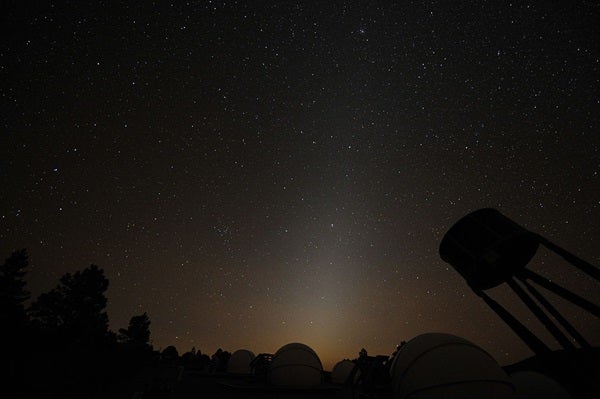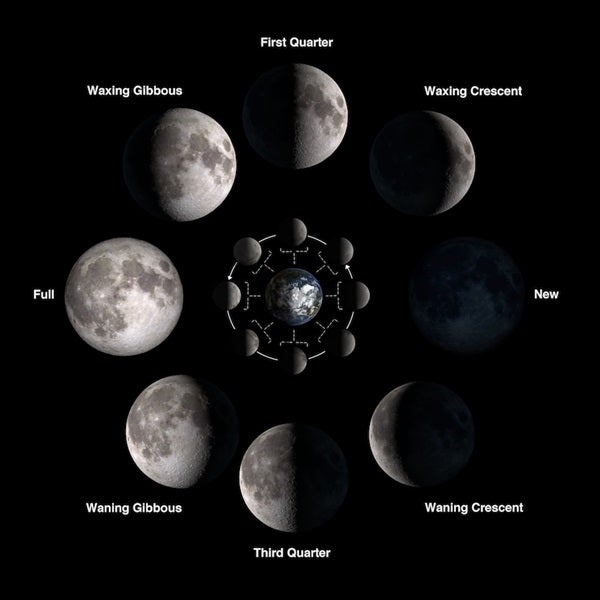This is a good week to look for Sirius in the evening sky. The night sky’s brightest star (at magnitude –1.5) appears highest in the south shortly after twilight ends. It then lies about one-third of the way from the horizon to the zenith when viewed from mid-northern latitudes. (The farther south you live, the higher it appears.) If you point binoculars at Sirius, look for the pretty star cluster M41 in the same field, just 4° below the star.
Saturday, March 3
After a long hiatus, both Mercury and Venus return to the evening sky in early March. The two neighbors lie low in the west during twilight and show up nicely through binoculars. Venus shines at magnitude –3.9 and stands 5° high a half-hour after sunset. Although Mercury appears just one-tenth as brilliant, at magnitude –1.2, that’s still bright enough to see if you have a clear and unobstructed horizon. This evening, Mercury lies just 1.1° to Venus’ right, their closest approach during 2018.
Sunday, March 4
March evenings offer an excellent chance to see the zodiacal light. From the Northern Hemisphere, late winter and early spring are great times to observe this elusive glow after sunset. It appears slightly fainter than the Milky Way, so you’ll need a clear moonless sky and an observing site located far from the city. With the waning gibbous Moon now exiting the early evening sky, this is the time to seek out the light (excellent conditions continue through March 18). Look for the cone-shaped glow, which has a broad base and points nearly straight up from the western horizon, after the last vestiges of twilight have faded away.
Neptune is in conjunction with the Sun at 9 a.m. EST. The distant planet is hopelessly lost in the solar glare but will return to view before dawn in April.
Although Mercury and Venus appeared closest to each other Saturday evening, the two officially reach conjunction today. Mercury slides 1.4° due north of Venus at 1 p.m. EST. In this evening’s twilight, Mercury stands to the upper right of its neighbor.
Tuesday, March 6
If you head outside after darkness falls and look to the west, you’ll see the stars of Taurus the Bull about halfway to the zenith. The V-shaped Hyades star cluster, which forms the Bull’s face, points straight toward the horizon. To the right of the Hyades lies the spectacular Pleiades star cluster (M45) and to the left are the glittering jewels that form Orion the Hunter’s shape.
Wednesday, March 7
The waning gibbous Moon passes 4° north of Jupiter today, and the two make a pretty sight all morning. You won’t have any problem identifying the planet because it’s the brightest point of light in this part of the sky, glowing at magnitude –2.2. Jupiter remains conspicuous all week, however. The giant world rises shortly after 11 p.m. local time and climbs highest in the south as twilight commences. The giant world resides among the much dimmer stars of the constellation Libra. A telescope reveals the planet’s 40″-diameter disk.
A pair of fine binocular objects shows up nicely on evenings this week. The open star clusters M46 and M47 reside about a degree apart in the northwestern corner of the constellation Puppis the Stern. The two lie about 12° east-northeast of the night sky’s brightest star, Sirius. The western cluster, M47, glows at 4th magnitude and appears as a fuzzy patch sprinkled with several pinpoint stars. Sixth-magnitude M46 shows up as a hazy collection of faint stars that is hard to resolve under most conditions. Although it contains nearly twice as many stars as M47, M46 appears fainter and fuzzier because it lies some three times farther from Earth.
Friday, March 9
Last Quarter Moon occurs at 6:20 a.m. EST. You can find the half-lit orb rising in the east shortly after 1 a.m. local time; it hangs about 30° above the southern horizon during morning twilight. Look to the Moon’s lower left and you can’t help but see the ruddy glow of Mars. The Red Planet shines at magnitude 0.7 and stands out nicely against the background stars of Ophiuchus. Unfortunately, Mars’ disk spans only 7″ when viewed through a telescope and shows little, if any, detail.
Saturday, March 10
The Moon’s eastward motion relative to the background stars carries it into Sagittarius this morning, where it appears equidistant between Mars and Saturn. The trio rises by 3 a.m. local time and looks stunning in the south-southeast as twilight starts to paint the sky. Unlike, Mars, magnitude 0.5 Saturn is worth observing through a telescope this week. The planet’s disk measures 16″ across while the spectacular rings span 37″ and tilt 26° to our line of sight.
Sunday, March 11
For most people in the United States and Canada, daylight saving time begins at 2 a.m. local time this morning. Set your clocks ahead one hour.
The Moon reaches apogee, the farthest point in its orbit around Earth, at 5:14 a.m. EDT. It then lies 251,455 miles (404,678 kilometers) from Earth’s center.












